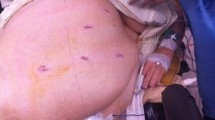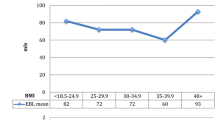Abstract
The prevalence of obesity is on the rise worldwide, and laparoscopic surgeons are facing an increasing number of obese patients.
Laparoscopic surgery is a safe alternative to open surgery in obese patients, and the laparoscopic approach has fewer operative complications, quicker recovery period, less hospital stay and less postoperative pain. In gynaecology, all of the surgical procedures commonly performed through laparoscopic route in women of normal weight have been studied and found to be safe in obese patients as well. They include adnexal surgery, myomectomy, total laparoscopic hysterectomy, management of tubal ectopic pregnancy, endometrial cancer, and pelvic/para-aortic lymph node dissection. Laparoscopy in these patients should involve a careful preoperative evaluation, ample preparation, adequate operative time, appropriate instrumentation and patient counselling.
Access this chapter
Tax calculation will be finalised at checkout
Purchases are for personal use only
Similar content being viewed by others
References
Mahmood T, Arulkumaran S, editors. Obesity- a ticking time bomb for reproductive health. London: Elsevier Insights; 2013.
Gomel V, Taylor PJ. Indications and contraindications of diagnostic laparoscopy. In: Gomel V, Taylor PJ, editors. Diagnostic and operative gynaecologic laparoscopy. 1st ed. St. Louis: Mosby-Year Book; 1995. p. 68–70.
Scribner Jr DR, Walker JL, Johnson GA, et al. Laparoscopic pelvic and paraaortic lymph node dissection in the obese. Gynecol Oncol. 2002;84:426–30.
Eltabbakh GH, Shamonki MI, Moody JM, Garafano LL. Hysterectomy for obese women with endometrial cancer: laparoscopy or laparotomy? Gynecol Oncol. 2000;78:329–35.
Heinberg EM, Crawford 3rd BL, Weitzen SH, et al. Total laparoscopic hysterectomy in obese versus non obese patient. Obstet Gynecol. 2004;103:674–80.
Lamvu G, Zoloun D, Boggess J. Obesity: physiological changes and challenges during laparascopy. Am J Obstet Gynecol. 2004;191(2):669–74.
Lean ME. Obesity and cardiovascular disease: the wasted years. Br J Cardiol. 1999;6:269–73.
Alexander JK. Obesity and cardiac performance. Am J Cardiol. 1964;14:860–5.
Hubert HB, Feinleib M, McNamara PM, Castelli WB. Obesity as an independent risk factor for cardiovascular disease: a 26 year follow up of participants in the Framingham heart study. Circulation. 1983;67:968–77.
Shenkman Z, Shir Y, Brodsky JB. Perioperative management of the obese patient. Br J Anaesth. 1993;70:349–59.
Valensi P, Thi BN, Lormeau B, Paries J, Attali JR. Cardiac autonomic function in obese patients. Int J Obes Relat Metab Disord. 1995;19:113–8.
Duflou J, Virmani R, Rabin I, Burke A, Farb A, Smialek J. Sudden death as a result of heart disease in morbid obesity. Am Heart J. 1995;130:306–13.
Murphy PG. Obesity. In: Hemmings Jr HC, Hopkins PM, editors. Foundations of anaesthesia. Basic and clinical sciences. London: Mosby; 2000. p. 703–11.
DeDivitiis O, Fazio S, Petitto M, Maddalena G, Contaldo F, Mancini M. Obesity and cardiac function. Circulation. 1981;64:477–82.
Ray C, Sue D, Bray G, Hansen JE, Wasserman K. Effects of obesity on respiratory function. Am Rev Respir Dis. 1983;128:501–6.
Biring MS, Lewis MI, Liu JI, Mohsenifar Z. Pulmonary physiologic changes of morbid obesity. Am J Med Sci. 1999;318:293–7.
Luce JM. Respiratory complications of obesity. Chest. 1980;78:626–31.
Vaughan RW, Bauer S, Wise L. Volume and pH of gastric juice in obese patients. Anesthesiology. 1975;43:686–9.
Lam AM, Grace DM, Penny F, Vezina WC. Prophylactic in- travenous cimetidine reduces the risk of acid aspiration in mor- bidly obese patients [abstract]. Anesthesiology. 1983;59:A242.
Oberg B, Poulsen TD. Obesity: an anesthetic challenge. Act Anaesthesiol Scand. 1996;40:191–200.
Wilson AT, Reilly CS. Anesthesia and the obese patient. Int J Obes. 1993;17:427–35.
Sprung J, Whalley DG, Falcone T, Warner DO, Hubmayr RD, Hammel J. The impact of morbid obesity, pneumoperitoneum, and posture on respiratory system mechanics and oxygenation during laparoscopy. Anesth Analg. 2002;94:1345–50.
Hurd WW, et al. The relationship of the umbilicus to the aortic bifurcation: implications for laparoscopic technique. Obstet Gynecol. 1992;80:48–51.
Curet MJ. Special problems in laparoscopic surgery. Surg Clin North Am. 2000;80:1093–110.
RCOG. Preventing entry-related gynecological laparoscopic injuries, RCOG green top guideline, vol. 49. London: RCOG; 2008.
Pelosi 3rd MA, Pelosi MA. Alignment of the umbilical axis: an effective manoeuvre for laparoscopic entry in the obese patient. Obstet Gynecol. 1998;92:869–72.
Santala M, Jarvela I, Kauppila A. Transfundal insertion of a Veress needle in laparoscopy of obese subjects: a practical alternative. Hum Reprod. 1999;14:2277–8.
Ahmad G, O’Flynn H, Duffy JMN, Phillips K, Watson A. Intervention review- laparoscopic entry techniques. The Cochrane Library; published online: 15 Feb 2012. doi:10.1002/14651858.CD006583.pub3. The Cochrane collaboration. Wiley: USA.
Bai SW, Lim JH, Kim JY, Chung KA, Kim SK, Park KH. Relationship between obesity and the risk of gynecologic laparoscopy in Korean women. J Am Assoc Gynecol Laparosc. 2002;9:165–9.
Author information
Authors and Affiliations
Corresponding author
Editor information
Editors and Affiliations
Rights and permissions
Copyright information
© 2015 Springer-Verlag London
About this chapter
Cite this chapter
Thanoon, O., Dewart, P., Mahmood, T. (2015). Laparoscopy in the Obese Patient. In: Metwally, M., Li, TC. (eds) Reproductive Surgery in Assisted Conception. Springer, London. https://doi.org/10.1007/978-1-4471-4953-8_14
Download citation
DOI: https://doi.org/10.1007/978-1-4471-4953-8_14
Publisher Name: Springer, London
Print ISBN: 978-1-4471-4952-1
Online ISBN: 978-1-4471-4953-8
eBook Packages: MedicineMedicine (R0)




